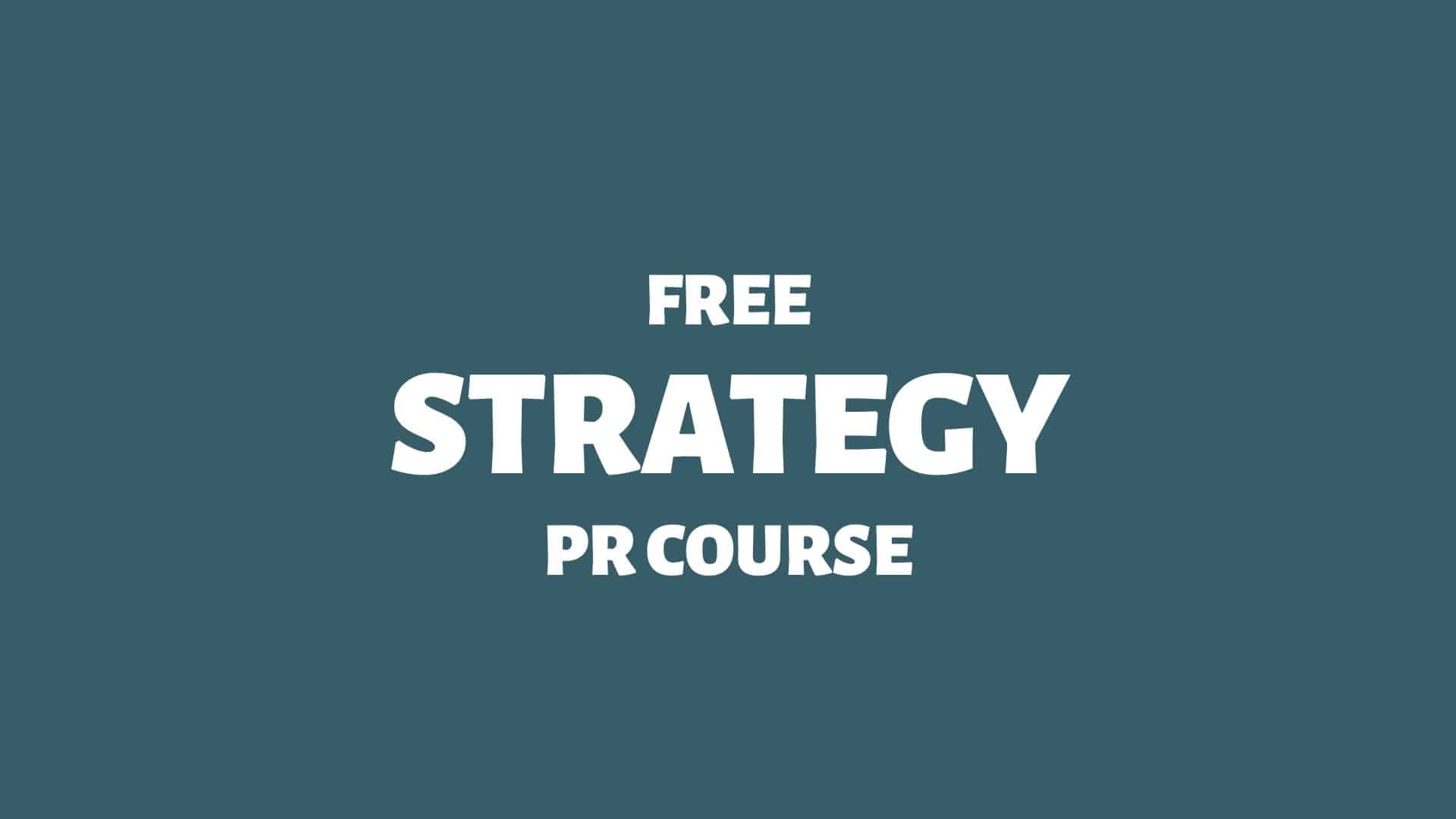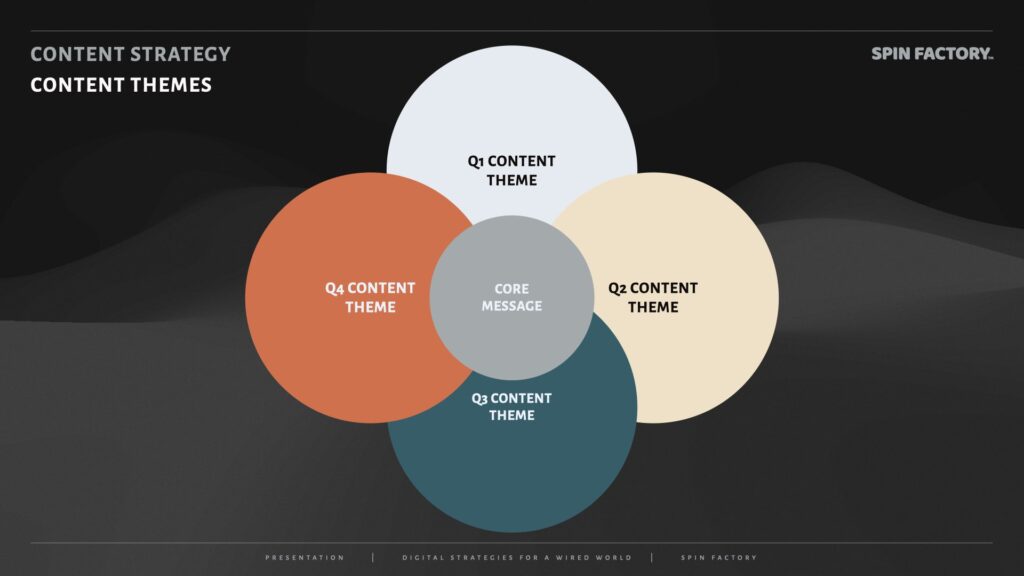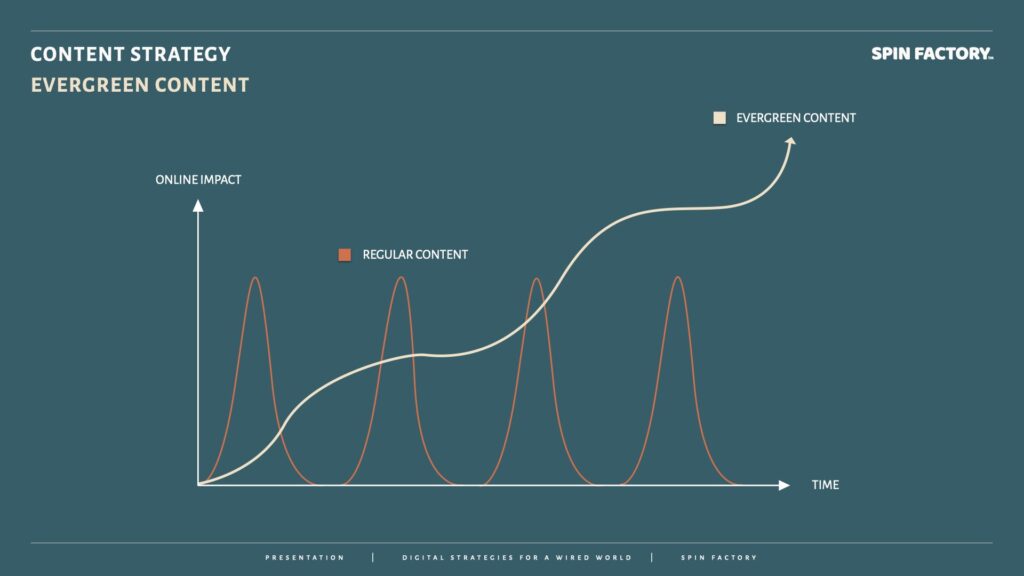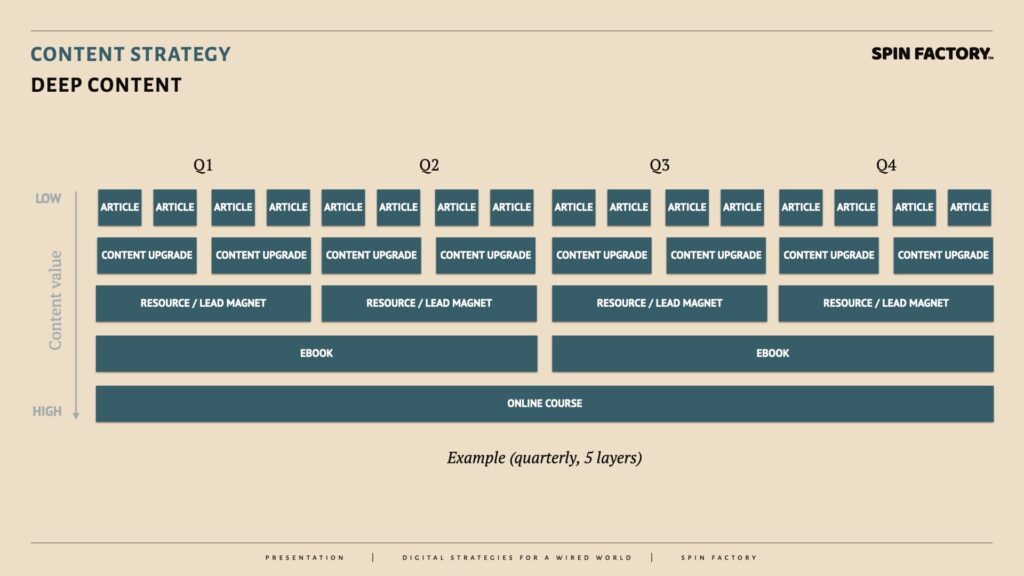What are content themes?
In this article, I will demonstrate the value of structuring your content into content themes and explain why you should consider applying this strategy for better results.
As a digital strategist, I’ve been designing content marketing strategies for numerous brands since 2005. Using content themes is a PR strategy accessible to almost any organisation.
Here we go:
Content Themes
It is good practice to structure the content calendar around content themes (typically four per year, one per quarter) showcasing varying aspects of the organisation’s core message.
Using content themes comes with several upsides:
For easy planning and boosting SEO with content skyscrapers, I often create content packages for each theme.
Content Themes Example
Let’s use a fictitious example of an IT company.
First, the IT company decide on a core message for their content strategy:
Core message: We make IT easy to understand.
Then, the IT company breaks their core message down into four business-critical content themes:
Q1 content theme: We make people understand the Internet of Things (IoT).
Q2 content theme: We make people understand business automation.
Q3 content theme: We make people understand cloud computing.
Q4 content theme: We make people understand managed services.
Learn more: The Content Themes PR Strategy
The Core Message
A core message is the foundational concept for all marketing and communication strategies.

Unlike a slogan, which can be seen as a catchy, often superficial tagline, the core message is a deeper, consistent narrative that conveys a brand’s fundamental values and promises.
Core message = the fundamental idea or promise that a brand consistently communicates across all platforms, defining its values and what it stands for in every interaction with its audience. 1Silfwer, J. (2024, May 2). The Core Message. Doctor Spin | The PR Blog. https://doctorspin.net/core-message/
Slogan = a catchy phrase or series of words used in marketing and advertising to quickly capture attention and accurately encapsulate a brand’s appeal or mission.
Together, the core message and the slogan ensure all communications and marketing activities are aligned, reinforcing the brand’s identity and mission across all platforms.
Please note: Seen as a promise, the core message must reflect the organisation’s main advantage over competing organisations. All marketing- and communication activities must reinforce this sentiment more clearly than any efforts by their competitors.
Core Message Examples
These examples showcase how the core message communicates a more profound, ongoing mission or customer promise. In contrast, the slogan is a catchy, immediate hook that complements and enhances the core message.
Red Bull
Apple
McDonald’s
Microsoft
Ikea
Nike
IBM
Spotify
Learn more: The Core Message
Content Packages (What To Include)
When establishing content themes, it’s best practice to produce content packages for each theme (to build content skyscrapers).

You should strive to produce various types of topic-specific content that will:
A package could contain the following types of topic-specific content:
Learn more: Content Packages (What To Include)
Evergreen Content
What’s evergreen content?
Evergreen content is an inbound approach to building core messages, content themes, content packages, deep content, and content skyscrapers.
For a piece of content to be evergreen, it must sustain its value over time. This means the content must be relevant today, tomorrow, and the foreseeable future.
While news content might make a more significant short-term splash, evergreen content accumulates online impact over time—which requires patience.
Now, forever is a long time. I typically apply these arbitrary rules to determine what constitutes evergreen content:
Learn more: The Evergreen Content PR Strategy
Deep Content
Deep content is focused on providing increasingly higher-quality information to content divers (as opposed to content surfers).
In the example, five layers of evergreen content are stacked vertically on a quarterly timeline:
Example of a five-layer deep content structure:
This inbound logic is similar to iceberg publishing and content themes regarding structure and depth.
Learn more: The Deep Content PR Strategy
The Blogger Outreach Focus
Many years ago, I first tested the concept of content themes myself.
I only published blog posts about “blogger outreach” for four months. I also gave seminars on the topic, created some visuals, sent out a few emails, and ensured I never published anything else during this period.
I’ve described this in My Content Marketing Experiment (That Failed Miserably), and it worked so well that it got me into some trouble:
The problem was that I became the “blogger outreach guy.” I don’t mind doing blogger outreach occasionally, but my focus has always been strategy. I should’ve picked the topic for my content theme more wisely.
The “One Thing Only” Challenge
I’ve helped clients structure their content marketing into themes, and I’m very proud of the results.
Many brands expect speaking about “only one thing” at a time to be challenging.
Can an IT company produce a comprehensive content package about business automation for a quarter? (Hint: Yes, they can!)
While posting a tweet is easy, you must stick to your message for an extended period. So, how do you talk about “one thing” for a longer period?
To come up with good ideas, it’s helpful to brainstorm.
In my experience, creating content variations is much easier than most might think. After all, I’ve been blogging around a content theme (i.e. public relations is a powerful business tool) for nearly two decades.
Once you start working as a team, the ideas will begin to flow, and you’ll soon have too many great ideas.
The actual “one thing only” challenge is actually of a different kind:
Content themes’ challenge is convincing your organisation not to speak about non-related matters. An organisation “chatters” all the time and convinces all functions to talk as one — that’s the challenge.

THANKS FOR READING.
Need PR help? Hire me here.

What should you study next?
Spin Academy | Online PR Courses

Spin’s PR School: Free Strategy PR Course
Unlock the power of strategic public relations with this free Strategy PR Course. Elevate your skills and boost your career today.
Public Relations Strategy 101
Public Relations Strategies
Grey-Hat PR Strategies
Learn more: All Free PR Courses
💡 Subscribe and get a free ebook on how to get better PR.

Annotations
| 1 | Silfwer, J. (2024, May 2). The Core Message. Doctor Spin | The PR Blog. https://doctorspin.net/core-message/ |
|---|





